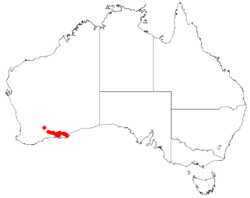Biology:Persoonia cymbifolia
| Persoonia cymbifolia | |
|---|---|
| Scientific classification Error creating thumbnail: Unable to save thumbnail to destination
| |
| Kingdom: | Plantae |
| Clade: | Tracheophytes |
| Clade: | Angiosperms |
| Clade: | Eudicots |
| Order: | Proteales |
| Family: | Proteaceae |
| Genus: | Persoonia |
| Species: | P. cymbifolia
|
| Binomial name | |
| Persoonia cymbifolia P.H.Weston[1]
| |

| |
| Occurrence data from Australasian Virtual Herbarium | |
Persoonia cymbifolia is a species of flowering plant in the family Proteaceae and is endemic to the south of Western Australia. It is an erect, spreading shrub with smooth bark, hairy young branchlets, linear to narrow oblong leaves and yellow flowers borne singly or in groups of up to three on a short rachis.
Description
Persoonia cymbifolia is an erect spreading shrub that typically grows to a height of 0.2–0.6 m (7.9 in–1 ft 11.6 in) and has smooth, mottled grey bark and densely hairy young branchlets. The leaves are arranged alternately, linear to narrow oblong, 15–45 mm (0.59–1.77 in) long and 1–3 mm (0.039–0.118 in) wide. The flowers are arranged singly, in pairs or groups of three along a rachis about 1 mm (0.039 in) long that grows into a leafy shoot after flowering, each flower on a pedicel 2–3.5 mm (0.079–0.138 in) long. The tepals are yellow, 7–11.5 mm (0.28–0.45 in) long and hairy on the outside with yellow anthers. Flowering occurs from December to January.[2][3][4][5]
Taxonomy
Persoonia cymbifolia was first formally described in 1994 by Peter Weston in the journal Telopea from specimens collected by William R. Archer near Mount Ridley north-east of Esperance in 1991.[4][6]
Distribution and habitat
This geebung grows in heath from the Frank Hann National Park to the Cape Arid National Park in the Coolgardie, Esperance Plains and Mallee biogeographic regions.[3][5]
Conservation status
Persoonia cymbifolia is classified as "Priority Three" by the Government of Western Australia Department of Parks and Wildlife[5] meaning that it is poorly known and known from only a few locations but is not under imminent threat.[7]
References
- ↑ "Persoonia cymbifolia". Australian Plant Census. https://biodiversity.org.au/nsl/services/apc-format/display/128862.
- ↑ "Persoonia cymbifolia P.H.Weston". Flora of Australia Online. Department of the Environment and Heritage, Australian Government. http://www.anbg.gov.au/abrs/online-resources/flora/stddisplay.xsql?pnid=44666.
- ↑ 3.0 3.1 Weston, Peter H.. "Persoonia cymbifolia". Australian Biological Resources Study, Department of Agriculture, Water and the Environment: Canberra. https://profiles.ala.org.au/opus/foa/profile/Persoonia%20cymbifolia.
- ↑ 4.0 4.1 Weston, Peter H. (1994). "The Western Australian species of subtribe Persooniinae (Proteaceae: Persooniodeae: Persoonieae).". Telopea 6 (1): 104–105. https://www.biodiversitylibrary.org/item/264631#page/108/mode/1up. Retrieved 11 October 2020.
- ↑ 5.0 5.1 5.2 "Persoonia cymbifolia". FloraBase. Western Australian Government Department of Parks and Wildlife. https://florabase.dpaw.wa.gov.au/browse/profile/15136.
- ↑ "Persoonia cymbifolia". APNI. https://id.biodiversity.org.au/instance/apni/557937.
- ↑ "Conservation codes for Western Australian Flora and Fauna". Government of Western Australia Department of Parks and Wildlife. https://www.dpaw.wa.gov.au/images/documents/plants-animals/threatened-species/Listings/Conservation%20code%20definitions.pdf.
Wikidata ☰ Q18081787 entry
 |


